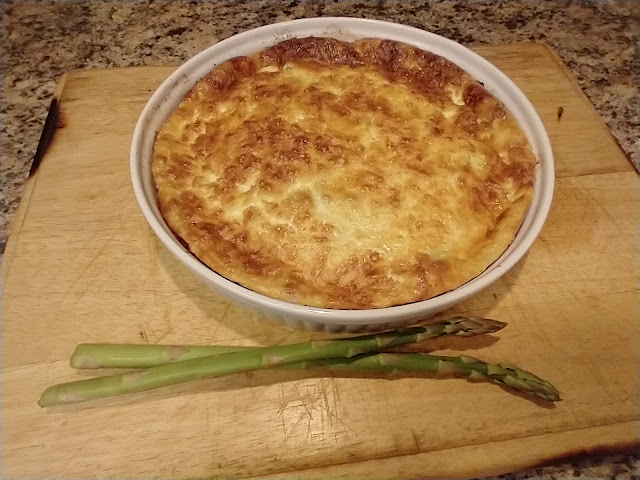
Recipe: Crustless asparagus quiche with pancetta and gouda
 |
| This crustless asparagus-pancetta quiche is perfect for Easter brunch. (Photos: Debbie Arrington) |
Better than any vegetable, asparagus represents spring; it’s literally spring shoots of a perennial fernlike plant. (Asparagus actually is a distant relative of onions.)
Asparagus has been a spring favorite since ancient Egypt. The Romans figured out how to freeze the shoots (in Alp snow) for later use. A recipe for cooking asparagus is included in one of the world’s oldest cookbooks, dating to first century A.D.
After generations of asparagus love in their native countries, European settlers brought asparagus crowns with them to the New World. Dutch immigrants grew asparagus as early as 1655 in the colonies.
Now, asparagus is a California specialty and plentiful this month, which makes it a good choice for building spring meals.
This easy no-crust quiche works nicely for Easter brunch – or any spring meal. It combines asparagus, pancetta and gouda cheese in a creamy egg filling. Pre-cooking the asparagus keeps the quiche from getting soggy.
Crustless asparagus quiche with pancetta and gouda cheese
Makes 6 servings
Ingredients:
2 cups fresh asparagus, cut into 1-inch pieces
2 tablespoons butter plus butter for pan
½ cup onion, chopped
½ cup pancetta or slab bacon, cubed
2 cup gouda cheese, shredded
5 eggs
1 cup heavy cream
½ cup milk
2 or 3 dashes hot sauce
Instructions:
Preheat oven to 350 degrees F.
Steam or microwave cut asparagus until fork tender but still vibrant green. (For microwave, cook about 6 minutes on high with ¼ cup water.) Drain and set aside.
In a frying pan, melt 2 tablespoons butter over medium heat. Saute onion until soft. Add pancetta and saute until edges start to brown. Add drained asparagus and saute lightly.
Butter a 10-inch pie pan or quiche pan. Transfer asparagus-pancetta mixture to pan, spreading evenly on bottom. Top asparagus mix with grated cheese.
In a bowl, beat eggs lightly. Add cream, milk and a few dashes of hot sauce.
Carefully pour egg mixture over cheese and asparagus mixture in pan. Place on center rack in preheated 350-degree oven. Bake 35 to 40 minutes or until top is golden and a thin-bladed knife stuck near the center comes out clean.
Let cool about 10 minutes before cutting. Serve warm or room temperature. Refrigerate any leftovers
 |
| Pre-cooking asparagus keeps quiche from getting soggy. |
Comments
0 comments have been posted.Sacramento Digs Gardening to your inbox.
Sites We Like
Garden Checklist for week of July 21
Your garden needs you!
* Keep your vegetable garden watered, mulched and weeded. Water before 8 a.m. to reduce the chance of fungal infection and to conserve moisture.
* Feed vegetable plants bone meal, rock phosphate or other fertilizers high in phosphate to stimulate more blooms and fruiting. (But wait until daily high temperatures drop out of the 100s.)
* Don’t let tomatoes wilt or dry out completely. Give tomatoes a deep watering two to three times a week.
* Harvest vegetables promptly to encourage plants to produce more. Squash especially tends to grow rapidly in hot weather. Keep an eye on zucchini.
* Pinch back chrysanthemums for bushy plants and more flowers in September.
* Remove spent flowers from roses, daylilies and other bloomers as they finish flowering.
* Pinch off blooms from basil so the plant will grow more leaves.
* Cut back lavender after flowering to promote a second bloom.
* It's not too late to add a splash of color. Plant petunias, snapdragons, zinnias and marigolds.
* From seed, plant corn, pumpkins, radishes, winter squash and sunflowers.